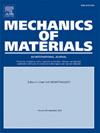Predicting the evolution of texture and grain size during deformation and recrystallization of polycrystals using field fluctuations viscoplastic self-consistent crystal plasticity
IF 3.4
3区 材料科学
Q2 MATERIALS SCIENCE, MULTIDISCIPLINARY
引用次数: 0
Abstract
This paper advances a recent formulation of a field fluctuations viscoplastic self-consistent (FF-VPSC) crystal plasticity model to predict not only the evolution of texture in polycrystalline metals undergoing deformation and recrystallization but also the evolution of grain size. The model considers stress and lattice rotation rate fluctuations inside grains to calculate intragranular misorientation spreads. The spreads are used for modeling of grain fragmentation during deformation and grain nucleation during recrystallization enabling the predictions of concomitant evolution of texture and grain size distributions. The evolutions of textures and grain size distributions are first simulated for commercially pure Cu undergoing severe plastic deformation (SPD) in high pressure torsion to agree well with corresponding experimental data. Next, the evolution of texture and grain size in an aluminum alloy (AA) 5182-O after simple tension and static recrystallization are predicted and compared with experiments. Finally, the predictions of texture and grain size distributions in a magnesium alloy WE43 undergoing a thermo-mechanical loading in the dynamic recrystallization regime are presented and compared with experiments. After validation, the model is coupled with the implicit finite element method (FEM) via a user-material subroutine (UMAT) in Abaqus to facilitate modeling of complex boundary conditions and geometries. The multilevel approach is referred to as FE-FF-VPSC in which every integration point embeds the FF-VPSC constitutive law, considering texture evolution and the directionality of deformation mechanisms operating at the single crystal level. FE-FF-VPSC is applied to simulate a sequence of rolling, recrystallization, and deep drawing of a circular cup of AA6022-T4. The simulated processing sequence demonstrates the versatility of the simulation framework developed in the present paper in not only predicting texture and grain size evolution and phenomena pertaining to behavior of materials but also geometrical shape changes important for the optimization of metal forming processes. To this end, the effects of initial texture and underlying anisotropy on the formation of earing profiles during deep drawing are simulated and discussed.
利用场波动粘塑性自洽晶体塑性预测多晶变形和再结晶过程中织构和晶粒尺寸的演变
本文提出了一种新的场波动粘塑性自洽(FF-VPSC)晶体塑性模型,该模型不仅可以预测多晶金属在变形和再结晶过程中的织构演变,还可以预测晶粒尺寸的演变。该模型考虑了晶粒内部的应力和晶格旋转速率波动来计算晶粒内部的取向偏差扩展。扩展用于模拟变形过程中的晶粒碎裂和再结晶过程中的晶粒成核,从而预测织构和晶粒尺寸分布的伴随演变。首次模拟了商业纯铜在高压扭转下剧烈塑性变形(SPD)的织构演变和晶粒尺寸分布,与相应的实验数据吻合较好。其次,对铝合金(AA) 5182-O经过简单拉伸和静态再结晶后织构和晶粒尺寸的演变进行了预测,并与实验结果进行了比较。最后,对WE43镁合金在动态再结晶过程中的织构和晶粒尺寸分布进行了预测,并与实验结果进行了比较。验证后,通过Abaqus中的用户-材料子程序(UMAT)将模型与隐式有限元法(FEM)耦合,以方便复杂边界条件和几何形状的建模。多层方法被称为FE-FF-VPSC,其中每个积分点都嵌入了FF-VPSC本构律,考虑了织构演化和在单晶水平上运行的变形机制的方向性。采用FE-FF-VPSC模拟了AA6022-T4圆杯的轧制、再结晶和拉深过程。模拟的加工序列证明了本文开发的模拟框架的通用性,不仅可以预测材料的织构和晶粒尺寸演变以及与材料行为有关的现象,还可以预测金属成形工艺优化中重要的几何形状变化。为此,模拟并讨论了拉深过程中初始织构和下伏各向异性对耳纹轮廓形成的影响。
本文章由计算机程序翻译,如有差异,请以英文原文为准。
求助全文
约1分钟内获得全文
求助全文
来源期刊

Mechanics of Materials
工程技术-材料科学:综合
CiteScore
7.60
自引率
5.10%
发文量
243
审稿时长
46 days
期刊介绍:
Mechanics of Materials is a forum for original scientific research on the flow, fracture, and general constitutive behavior of geophysical, geotechnical and technological materials, with balanced coverage of advanced technological and natural materials, with balanced coverage of theoretical, experimental, and field investigations. Of special concern are macroscopic predictions based on microscopic models, identification of microscopic structures from limited overall macroscopic data, experimental and field results that lead to fundamental understanding of the behavior of materials, and coordinated experimental and analytical investigations that culminate in theories with predictive quality.
 求助内容:
求助内容: 应助结果提醒方式:
应助结果提醒方式:


